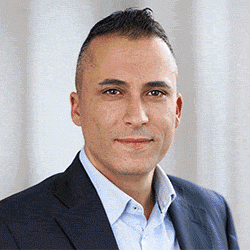"Each of the eleven communities has its own requirements - with Ineract Service and Luma luminaires, we meet them"
In this interview, Manuel Iseli, Division Manager Network Provider Electricity Truck, tells us how they deal with the different requirements of the various communities, which is the favorite luminaire in the neighboring country and why, in his eyes, the future trends in public lighting could not be more different.
Mr. Iseli, in Liechtenstein you started refurbishing to LED at a very early stage - how did this come about?
The Liechtenstein Power Plants (LKW) operate the public street lighting of all eleven municipalities in Liechtenstein on a contract basis, with a total of around 8700 light points, which are owned by the municipalities. In 2011, we were allowed to install the first LED lights in Liechtenstein. An area-wide refurbishment over several annual stages began in the municipality of Vaduz in 2012.
Is there a "favorite" luminaire that you use?

What role does lighting control play in this?
With the Luma family of luminaires, we also introduced the Interact City lighting control system (then called DynaDim+). Our challenge was to be able to meet the different needs of the 11 municipalities. Each municipality has its own requirements, these could be met for the most part with Interact City.
By how much have you been able to reduce energy consumption in recent years through LED lights and appropriate control?
The municipalities of Liechtenstein have been able to reduce the energy consumption of public lighting by 30% since 2013. This clearly shows the energy efficiency of LED technology.
How do you deal in the "Ländle" with the issue of light pollution, protection of sensitive ecosystems and residents from stray light (so-called light pollution)?
The majority of the LED luminaires led to a significant decrease in the effect of stray light. In addition, during the planning process of public lighting, we always adhere to the guiding principle "as much light as necessary - as little as possible". So far, we have succeeded very well.
Are there any specific projects that you can tell us about?
In one municipality, for example, motion-dependent lighting control is being implemented across the board in neighborhood streets using Eagle Eye radar sensors. On the one hand, this reduces light emissions many times over, and on the other hand, energy consumption can be further reduced.
Lights on demand, thanks to Eagle Eye radar sensors - leading light for less-traveled side streets
All eleven municipalities carry the Energy City label: what influence does the aspiration of many municipalities have on your work?
There are many ways to obtain the Energy City label. Reducing the energy consumption of public lighting is one of them. Some municipalities have worked out multi-year renovation stages with our expert support to achieve individual energy targets. Our task in each case is to make this sometimes complex subject understandable to the customer in a simple way. The multi-year redevelopment stages will now increase the stock of LED luminaires to 70% by the end of 2021.
Are there any major challenges in your day-to-day work with the many communities, as needs and starting points are different everywhere?
Our biggest challenge is to take the needs of the 11 communities and try to offer a common solution. It is increasingly apparent that this is no longer as simple as it was 15 years ago. Today, 11 communities often mean twice as many contacts and three times as many ideas, which does not make the operating and planning process efficient in every case.
Looking to the future: what trends do you see as shaping the future of public lighting?
We see two trends that could not be more different. One trend points in the direction of new technologies, sensor technology, control, smart city. The luminaire is moving more and more into the background, which in itself is not wrong, but in a sense corresponds to the spirit of the times. The new technologies with their possibilities are received with interest by the customer and realized in individual projects. The other trend points in the direction of "back to the roots". The most cost-effective and efficient public street lighting possible, which serves the original purpose of reliably illuminating the street.
In conclusion: How is the cooperation with ELEKTRON for you?
On the cooperation with ELEKTRON, we particularly appreciate the direct communication, uncomplicated solutions and fast response times.
"For more than 20 years I have been able to look after the trucks with great pleasure".
How long have you been working with the trucks?
The cooperation of ELEKTRON and the Liechtensteinische Kraftwerke already lasts about 25 years. For 19 years, I myself have been allowed to look after this loyal customer with great pleasure.
What do you particularly appreciate?
The long-standing relationship with the company and the employees. The team is very pleasant and the cooperation is associated with great mutual trust. The employees / at the truck Schaan are almost exclusively people who have been there for many years and whom I have been allowed to look after since the year 2002. The mutual appreciation provides a very good basis for a successful business relationship.
How do you see the situation of public lighting in Liechtenstein?
I experience the country of Liechtenstein with its 38,000 inhabitants as very open-minded, innovative and open to new technologies. LKW serves all 11 municipalities in the country. In recent years, about 70% of the approximately 8700 street lights have already been replaced with LED lights.



